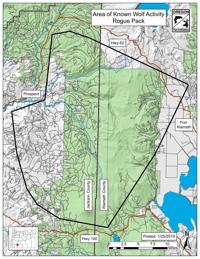https://www.heraldandnews.com/news/local_news/wolves-implicated-in-three-cattle-kills/article_b1c7456d-35ec-53df-a693-5305a9fa6b45.html
 Wolves
implicated in three cattle kills in Fort Klamath Wolves
implicated in three cattle kills in Fort Klamath
Herald and News by Lee Juillerat 10/26/18
A trio of cattle
deaths in the Fort Klamath area earlier this week are being
blamed on the Rogue Wolf Pack.
The carcasses of
three yearling heifers were found Monday, Tuesday and Wednesday
mornings by Butch Wampler, who oversees cattle grazing on Wood
River Valley ranch lands owned by Bill Nicholson and leased to
DeTar Livestock of Dixon, Calif. The remains have been sent for
examination before an official determination is made.
Following the
discovery of the first heifer Monday morning, Nicholson said the
carcass was too badly eaten to determine how it died. A second
dead heifer was found Tuesday morning. Both had been buried but
were unearthed following the discovery of a third heifer
Wednesday that, according to Nicholson, showed traits consistent
with a wolf kill. After the dead heifer that was discovered
Tuesday was unburied and skinned, it was determined it also
showed traits consistent with a wolf kill.
After finding the
third dead heifer, Nicholson contacted Tom Collum, the Oregon
Department of Fish & Wildlife’s Klamath Falls district
biologist. Video cameras showed six gray wolves from the Rogue
Pack, including OR-7, who is collared but no longer transmitting
signals, in the Fort Klamath area.
Deterrents
Collum spent
Wednesday night camped in a field near the grazing cattle. Other
biologists are scheduled to take turns in the field the next
several night in efforts to deter the wolf pack. In 2016, when
four grazing cattle were attacked and eaten alive by wolves,
Collum and others took turns staying overnight using non-lethal
methods — massive bonfires, honking horns, beaming strobe lights
and firing cracker shells, which travel about 100 yards before
exploding — as part of an effort to deter wolf predation.
“We didn’t know the
Rogue Pack was back in this area,” Collum said Wednesday, noting
they had been seen on the Jackson County side of the Cascades.
Last month it was determined a large dog guarding cattle near
Prospect had been killed by a wolf. The last confirmed cattle
attack by the Rogue Pack was in January, when two calves were
killed two days apart near Butte Falls.
Tracking
Emphasizing that no
final determination has been made on the deaths of the three
Fort Klamath area heifers, Collum described the kills discovered
Tuesday and Wednesday as “textbook.” The carcass of the heifer
discovered Monday may be too destroyed to make a determination.
He said tracking is difficult because none of the Rogue Pack
wolves have operating monitors.
Each summer upward of
35,000 cattle graze on Wood River Valley pastures. Most have
been trucked to pastures in the Redding-Cottonwood area of
northern California. The relatively small numbers of remaining
cattle will be shipped out within the coming month. Nicholson
noted all three of the dead cattle are heifers, year-old cows
weighing 550 to 650 pounds that have not produced calves. On
neighboring fields with mother cows and calves, he said there
have not been any known wolf attacks.
“I think maybe the
cows protect the calves,” Nicholson speculated.
Noting the same
trend, Collum said, “They’re not protected the same way (as
calves with cows). The wolves seem to know that.”
====================================================
In accordance with Title 17 U.S.C.
section 107, any copyrighted material
herein is distributed without profit or
payment to those who have expressed a
prior interest in receiving this
information for non-profit research and
educational purposes only. For more
information go to:
http://www.law.cornell.edu/uscode/17/107.shtml |

